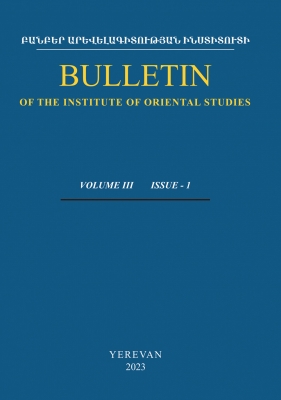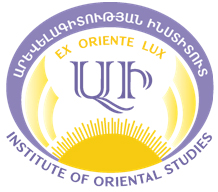Articles
- Robert Ghazaryan
Issues of the history of the Early Hittite Kingdomp.p 17-29
Abstract
The Hittite state is closely related to the kingdom of Kanesh by historical ties. Its back-ground could be understood through the study of the last stage of the history of the city-state Kanesh or Nesa in the second half of the II millennium BC. It is also essential to understand how the transition of the state system from Kanesh to Hattusa took place. It is equally necessary to find the connection between the kings of the Old Hittite Kingdom and the Kanesh dynasty and the influence that the state system of Kanesh had on the Old Hittite state. The article discusses the above-mentioned issues, as well as a number of other issues of the history of the Early Hittite state.
- Aram Kosyan
The settlements of Išuwa in the II millennium BCp.p 30-36
Abstract
In the cuneiform Hittite texts there are attested 21 place-names located on the territory of Išuwa. The investigation of archaeological sites of the region shows that their number was definitely incomparably more. In the article are collected place-names of Išuwa attested by name. The list is assorted according to their appearance in the texts. In numerous archaeological sites there have been registered cultural layers which cover a long period of functioning from the Early Iron Age to Middle Ages that testify in favor of continuity, regardless the ethnic affiliation of their population (Hinzuta-Andzit, Pališna-Palin, Tahhiša-Degiq).
- Ruben Manaseryan
The “Courtesy” (Comitas) of king Vononèsp.p 37-43
Abstract
The Parthian king Vononès (8-12), being full of benevolence and courtesy towards his sub-jects, was however driven out by his nobility. This fact was the consequence of the oppo-sites of thepolitical mentality of the Roman and Parthian societies. Vononès, who returned to the Parthian throne after a long stay as a hostage in Rome, tried to transfer the way of leadership of republican Rome to a tribal society based on the principles of collectivism and personal leveling. In the ideas of the Parthians, the king (vir magnus - Just XLI,6.1) is the embodiment of physical masculinity and exercises power by means of readiness for violence, threats and, accordingly, stimulating fear in his subjects. The fear of the monarch is an incentive to implement his will. The “courtesy” (comitas) of Vononès, which Tacitus speaks of, being a characteristic feature of the political communication in republican Rome, was introduced by him into relations with the subjects. It denied the traditional prin-ciples of exercising power by the Arsacids on interpersonal level, and destroyed traditional ideas about the king-lord. We could presume that Vononès practically abolished fear as a means of exercising supreme power. Emperor Claudius, who pursued a policy of terror against the Senate and equites, urged the pretender to the Parthian throne the prince Meherdat to follow the official ideo-logical setting of the principate - an ideal relationship between the ruler (rector) and citizens and not rule as a despot of slaves. These words to Meherdat expose a calculation that the pursuit of these political precepts will only lead to further unrest within the Parthian Empire identical to that which overthrew Vononès.
- Arthur Matevosyan
The dogma of the Holy Trinity in the Letter of Eznik of Kołb “To the Blessed Archimandrite Mashtots”p.p 44-51
Abstract
“The Book of Letters” contains Eznik of Kołb's letter “To the Blessed Archimandrite Mashtots”, which is one of the key documents reflecting the creed of the Armenian Church of the 5th century. The dogmatic system of the Armenian Church is based on the Niceno-Constantinopolitan creed, according to which God is one essence and three Hypostases. It means that the one God is eternally personified in the Hypostases of Father, Son, and Holy Spirit. Each Hypostasis contains the fullness of the divine essence, so the three Hypostases are equally perfect God, yet not three Gods, but one God. It is so, because the divine es-sence is one and does not exist independently of the Hypostases. The Christian doctrine of the God-Man makes sense only if the divine nature of the Incarnate Word in Jesus is rec-ognized. For this, it is necessary that all the Hypostases of the Holy Trinity are consubstan-tial and equally perfect. The Son is as much God as the Father and has all the attributes attributed to the Father. Although the Father is the cause of the Son's existence, the birth of the Son cannot in any way be considered the result of an act of the Father's will. It is an eternal and ineffable birth that necessarily takes place in the transcendent depths of the divine nature. The only begotten Son is begotten of the Father in eternity, and has all the attributes of the Father except that He is not begotten. In the same eternity, the Holy Ghost proceeds from the Father. There is no temporal sequence between the Hypostases. They are coeternal and have the same nature, power and will.
- Adam Kubik, Oleg Radyuš, Leonid Vyazov
On one series of the VI century AD iron one-piece asian helmetsp.p 52-82
Abstract
The article describes a series of helmets of a type that probably spread across Asia and Eastern Europe in the middle to the second half of the VI century AD. These helmets are characterised by a very particular construction: they have a bowl hammered from a single piece of iron, with an additional band in the lower part, connected to the inside or outside edge of the helmet. Additionally, a chainmail collar was attached to the lower part of the helmet. The attached chainmail provides additional protection around the entire circum-ference including the forehead above the eyes. This characteristic would remain unpopular in European armaments for quite a long period and was only popularised in central and eastern Europe around the XVI century AD [1: 130]. This article analyses a possible Irani-an provenance of the helmets of this type as well as hypothesizes about the possible rea-son for the spread of these helmets on the territory of Eastern Europe and Asia.
- Kristine Kostikyan
Armenian kalāntars of the towns of Transcaucasia in the 17th-18th centuriesp.p 83-91
Abstract
Kalāntars were the high officials of Ṣafavid, Afshārid and Qājār administration of towns, who managed the affairs referring to handicraft production and trade there. During the predominance of the Iranian states of the period the towns of Transcaucasia had kalān-tars, and more often Armenian kalāntars were at the head of the towns, where Armenians formed the majority of the urban population. Armenian kalāntars were usually the repre-sentatives of local elite families of eminent melik‘s and merchants. The research on the topic has helped reveal the names of a few Armenian kalāntars in Agulis, Zagam, Loṙi, Erevan, Barda and Tiflis, also trace some peculiarities in the func-tions of this official in the region. The kalāntars of the mentioned towns usually managed the affairs of not only the town, but also those of the surrounding villages, since handi-crafts and trade were among the main occupations of the inhabitants of many Armenian villages. The next peculiarity of office in the regions is the frequent cases of transmission of the post from father to son.
- Davit Merkviladze
Plans of Erekle II, King of Kartli-Kakheti as regards the Campaign of Russian Troops in Dagestan in 1775p.p 92-101
Abstract
In the spring of 1775, in order to punish the Kaitag Utsmi Amir-Hamza, a military expedition of Russian troops under the command of General Medem was sent to Dagestan, after which, at the invitation of Fatali Khan of Derbent, these troops entered the city of Derbent. King Erekle II of Kartli-Kakheti soon responded to this campaign and tried to interest the Russian authorities in a long stay of Russian troops in the city of Derbent, and also suggested that they continue the campaign of troops in the South Caucasus. In a letter to General Medem dated May 6, 1775, Erekle II suggested that he move to the South Caucasus with his army. Promising General Medem all-encompassing support on behalf of all the Christians of Transcaucasia, King Erekle emphasized the ease and further unhindered march of Russian troops. On May 29, King Erekle sent a letter to the head of foreign policy of the Russian Empire, Nikita Panin, in which, reproaching the imperial court for neglecting the interests of the Georgian Kingdom and all Transcaucasian Christians in the last Russian-Turkish war (1768-1774), he asked to order General Medem to continue the campaign in the South Caucasus. According to the King, in this case, given the situa-tion, all the inhabitants of the Transcaucasian khanates, both Christians and Muslims, would declare obedience to Russia. In the words of King Erekle, such an action by the Rus-sian army would be a great consolation for all Christians living between Derbent and his kingdom. As a result of the analysis of the content of the above-mentioned letters, it can be concluded that the “minimum plan” of Erekle II regarding the campaign of Medem to the North-Eastern Caspian was to maximize the stay of Medem's troops in Derbent, and the "maximum plan" was the advancement of these troops to Shirvan and their approach to the borders of the Kartli-Kakheti Kingdom. Naturally, in this case the King of Kartli-Kakheti was guided by the interests of his kingdom. Probably, on the one hand, Erekle II wanted to use Medem's troops, if they en-tered Shirvan, to spread and strengthen his power over some of the khanates of the South Caucasus. And if Petersburg had not agreed to advance the army in Transcaucasia and would have left them in Derbent, this circumstance would have made it easier for King Erekle to fight against the predatory raids of the Dagestanis, and might have made it possi-ble to try to annex the East Kakhetian region - Char-Belakani, appropriated by the Dage-stanis, to his kingdom. The aforementioned initiative of Erekle II was unsuccessful: Medem was ordered to refrain from answering the King's letter. Soon Medem was recalled from Derbent, and then part of the Russian troops stationed there left this strategic point. Such decisions of the Russian Imperial Court largely determined the subsequent foreign policy steps of the Geor-gian King, in particular his political rapprochement with the Ottoman Empire.
- Myasnik Esoyan
Coverage of the situation of Western Armenians in Egyptian-Armenian press (1899-1904)p.p 102-113
Abstract
The developing relations of production caused a great revival in the economic life of Egypt starting with the second half of the 19th century. Armenians who migrated to Egypt took an active part in the development of the country's economic and cultural life. The revitaliza-tion of the economic and cultural life of Egypt has caused significant positive changes in the social and cultural life of Egyptian Armenians, where the Armenian periodical press has been doing a lasting job. The Egyptian-Armenian press has always been concerned about the situation in Western Armenia and Cilicia. In addition, Egyptian-Armenian periodicals have set themselves the task of keeping alive the hope of reviving the Motherland, uniting the Armenian immigrants settled in different countries all across the world around that idea.
- Tereza Amryan
On teaching of Persian language in Armenian schools of Iran in the second half of the 19th century and the first half of the 20th centuryp.p 114-129
Abstract
In the article, the activities of Armenian schools in Iran in the second half of the 19th century and the first half of the 20th century, and the teaching of the Persian in those schools are addressed. The purpose of the study is to examine the teaching of Persian in Armenian schools․ For conducting the research historical and comparative-historical meth-ods have been used․ In the second half of the 19th century and at the beginning of the 20th century the Armenian schools of Iran were influenced by the Armenian schools of the Caucasus. They often brought educational literature from Tbilisi to Iran and sometimes invited teachers from there. Along with foreign languages, Persian was also taught at Armenian schools in Iran. During the years of the constitutional movement, the classes of Persian language became more widespread in Armenian schools. During the reign of Reza Shah, the management of all schools in the country came under the control of the state, and the teaching of Persian became mandatory in all schools. Thus, in the second half of the 19th century the teaching of Persian facilitated the integration of students into economic and social life, but after educational reforms and standardization of school cur-riculum, the teaching of Persian gradually became mandatory and standardized in all Ar-menian schools of Iran.
- Gao Jianzhi
The German-Turkish relations during the Macedonian reforms (1903-1908)p.p 130-146
Abstract
In February 1903, with the introduction of Austro-Russian “The Vienna Scheme”, the Macedonian issue became a European-wide problem. The diplomatic games of the Great Powers over the Macedonian reforms became one of the key factors affecting the adjust-ment of relations among the Great Powers. In order to expand its influence in Turkey and develop German-Turkish relations, Germany mostly stayed out of the Concert of Europe on Macedonian reforms and hindered the reform process. However, when faced with a choice between Austria-Hungary and the Ottoman Empire, Germany sided with its ally Austria-Hungary. The Ottoman Empire took advantage of the differences among the Great Powers on the Macedonian reforms to slow down the reform process as much as possible and maintain the integrity of its European territory. However, in the face of the coercive power of the Great Powers, the Ottoman Empire’s claims of sovereignty and struggles often faced failures. In order to avoid the complete collapse of the Empire, the Ottoman Empire tried to develop German-Turkish friendship during the Macedonian re-forms, and this diplomatic choice became the main basis for the implementation of na-tional policy in the future and promoted the reorganization of the European power struc-ture.
- Anush Harutyunyan
The ethnic structure of Soviet Azerbaijan (based on the materials of agricul-tural census of 1921)p.p 147-159
Abstract
The article is devoted to the investigation of the ethnic structure of Soviet Azerbaijan based on the materials of the agricultural census, which conducted in summer of 1921. The data of the census published in the pages of “Izvestiya” of Az․ CSD from 1921 to 1924 and in publications dedicated to each uezd (administrative unit). The articles published in these magazine and books deal with different issues of Azerbaijan’s society: branches of agriculture, cargo transportation, trade, education and schools, but we are interested in that information, which introduce the ethnicity of the republic. The importance of these materi-als is essentially high. It shows how many ethnic and subethnic groups had been living in the current territory of Azerbaijan, what language they spoke, what kind of ethno consoli-dation processes had been fixed, thus, how they expressed their ethnic identification and what kind of theoretical and practical problems arose during the identification process.
- Xin Yin
The Carter administration’s policy towards Afghanistanp.p 160-176
Abstract
The Carter administration came to power at a crucial period when the relations between the East and the West were shifting from relaxation to re-confrontation. Its policy towards Afghanistan was not only restricted by the situation of U.S.-Soviet Union relations but also exerted a direct influence on the maintenance and transformation of this situation, notably the opening of the “New Cold War” between the East and the West. With the evolution of the Carter administration’s policy towards Afghanistan as the main clue, this paper aims to study the formation background, causes of change and development logic of different US policies towards Afghanistan in this period so as to reveal the internal relationship between the change of the U.S. policy towards Afghanistan and the evolution of the Cold War situ-ation, as well as the essence of the U.S. policy.
Scientific Life
- Monika Mirzoyan
International conference “Problems of the history of the Caucasusˮ dedicated to the 75th anniversary of Pavel Chobanyan (1948-2017)p.p 177-183
 English
English Հայերեն
Հայերեն











